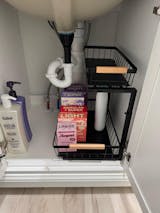Using a tampon for the first time can be scary, we get it!
But we’re here to teach you ‘Tampons 101’: a guide to all of your tampon related questions.
Trust us, by the end of this article you’ll be a tampon-pro, ready to teach any other menstruator who's interested in trying tampons how to use them comfortably.
What is a tampon?

A tampon is a wad of cotton used to absorb blood in your vaginal canal during your period.
The best organic tampons are made of 100% organic cotton that’s free of fragrances, dyes, pesticides and harmful chemicals that you want to keep out of your most intimate area. (Like August’s!)
How do tampons differ from panty liners and pads?
Tampons are internal; made to be inserted inside of you, unlike pads and liners, which rest on your underwear to absorb the blood.
The absorbency of all products differ.
- August Tampons come in 3 absorbencies: light (up to 6mL), regular (6-9mL) and super (9-12mL) and need to be changed more often to avoid TSS and overflow.
- August pads come in 4 sizes: liners (5mL), day pads (60mL), night pads (80mL) and our newly launched long night pads (100mL).
How to insert a tampon:

-
For first timers, using tampons with smooth, rounded applicators may make it easier. If you’re having trouble, ask someone you trust (like a parent, sibling, or another person you trust) to help coach you through it in-person.)
-
This process is a lot more comfortable if you’re relaxed, so take a deep breath, wash your hands, and get into a comfortable position – you can squat, put one leg up, or sit on the toilet with your knees apart. You’ve got this!
-
You might be wondering which hole to put it in or if you can accidentally enter it into the wrong hole – completely normal questions! The tampon goes into the vaginal opening which is between the urethra (where the pee comes out) and the anus (you know what the butthole is for…). The vaginal opening usually has the shape of an oval rather than a round circle.
-
Hold the applicator with your middle finger & thumb, and place your index finger on the smaller, pushing part of the applicator. Push the tampon into your vagina at a 45 degree angle, as far as the applicator base allows it to (August’s BPA-free tampons with applicators are about 40-50mm).
-
Throw the wrapper and applicator in the trash — don’t flush them (or any part of the tampon) since they can clog your pipes and run into nearby waterways.
-
Stand up and make sure that the tampon feels comfortable. If you can feel it quite a bit, try pushing it in a little further to adjust it.
-
You’ll notice a string hanging out of your vagina. Once you’ve soaked through your tampon or after 4-8 hours – whichever comes first – gently pulling on that string will get the tampon out. It’s easier to take your tampon out when it’s wet from absorbing the max amount of period flow it can.
-
Wrap used tampons in toilet paper and throw them away in the trash — again, don’t flush them!!
And that’s it! You’ve successfully inserted a tampon. Is it your new favorite period product yet?!
How do I insert a cardboard tampon?
See above: You can insert it the same way you would using a plastic applicator.
How long can you leave a tampon in?
You’ll get to know your regular flow with more practice, but changing it more often is always better!
With tampons, 4-6 hours is recommended and 8 hours is the max. The reason there is a time cap to wearing a tampon is to reduce the risk of Toxic Shock Syndrome (TSS), which can occur when a tampon is worn for too long.
Read our full explanation, diagnosis, and treatment plan of TSS HERE.
Fun fact though: strep throat is actually a more common cause of TSS than tampon use! Just remember to change it out often and get to know your flow.
Can you pee and poop with a tampon in?
Yes you absolutely can do both! But, if you’d prefer not to, just take out the tampon and change it out for another.
-
Your pee hole and the hole your tampon goes into are two different holes, so there’s no issue there.
-
The only health risk to having one in when you poop is that bacteria might end up on the string and then touch your vulva. Avoid this by pulling the tampon string to the front before you push and don’t wipe it all together.
p.s. don’t be alarmed if the product does pop out from pushing too hard – just put a new one in!
Is it bad to sleep with a tampon in?

As long as you are able to change it before bed, and right when you wake up, then it’s okay to sleep with it in.
Remember, depending on your flow, you may need a higher absorbency overnight, and it’s still recommended to change every 4-8 hours, even when you’re sleeping.
Dr. Heather Irobunda (she/her), MD, FACOG wanted to remind everyone to also read and follow the manufacturer’s instructions when using this type of period care.
If you’re an August subscriber peep the inside of your tampon box: we provide handy leaflets that even have diagrams on how to insert a tampon.
Can you swim with a tampon in?

Tampons are perfect to wear while swimming or spending the day at the beach!
You might have a little leakage because, contrary to myths, your flow does NOT completely stop in the water (it is reduced, but not stopped). But at least you’ll have a safeguard for when you get out of the water. Just don't get distracted building sandcastles and remember to change it...
Also, swimming on your period is actually a great form of exercise to potentially relieve cramps!
Can I shower with a tampon?
Similar to swimming on your period, you can totally shower with this type of menstrual product in or shower without any products at all – It’s your choice!
Can a tampon get lost?
It’s not possible for it to get completely lost inside of you. It will be stopped at your cervix, the only other opening in the vagina, which is too small for a tampon to pass through.
How to remove a stuck tampon?
If the string does fluke and break off, your tampon will stay inside of you until you remove it. So be sure to head to emergency care as soon as you realize you’re unable to get it out with just your fingers.
Can a tampon break your hymen?
Yes, a tampon could 'break' your hymen but it's nothing to be too concerned about.
The hymen is just a thin layer of skin so it is common to be worn down gradually by other physical activities (i.e. horseback riding, riding bikes, gymnastics, climbing trees, running, or even dancing).
By the time you put a tampon in, it will likely already be much thinner.
If I use a tampon am I still a virgin?
First of all, this type of period product works equally as well for people who have or haven’t had sex. A tampon is officially registered as a medical device, nothing to do with virginity.
Second of all, virginity is a social construct made to make people feel shameful about sex. Even your doctor can’t usually tell if you have or haven't had sex!
So, using a tampon doesn’t ‘take away’ your virginity. Only your first (consensual) sexual experience with someone change that. And that should completely be at your own discretion.
Do tampons make cramps worse?

According to Dr. Bala (she/her), ND, tampons can worsen cramps for some people.
It’s not always related, but for those with pelvic floor dysfunction, vaginismus, or other irritability in the vagina, tampons can create more pain.
If you also have pain with intercourse, that’s a sign the issue may be a pelvic floor issue.
If tampons aren’t your thing, then switch to pads! August offers 4 sizes of ultra-soft, organic cotton pads and liners.
Before you go, let’s talk about the Tampon Tax

August believes that this unfair sales tax placed on menstrual products has got to go! So, if you are ordering from any of the U.S. states that still have a tampon tax in place, we will cover it when we're legally allowed.
































